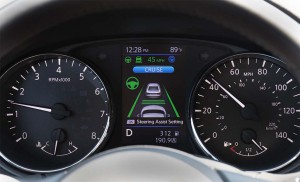New safety systems, such as blind-spot detection and forward collision warning, can help motorists steer clear of trouble, but when a collision does occur, warns a new AAA study, the cost of making repairs is likely to skyrocket.
And even something as simple as replacing a broken or chipped windshield can create real headaches, not only adding to the cost of a repair but requiring motorists to find a properly equipped collision shop with properly trained technicians.
The problem is expected to become much more widespread in the years to come, as automakers are now making advanced driver assistance systems, or ADAS, available on a growing line-up of products, often as standard features, or as part of low-cost safety packages.
“Advanced safety systems are much more common today,” said John Nielsen, AAA’s managing director of Automotive Engineering and Repair. “It’s critical that drivers understand what technology their vehicle has, how it performs and how much it could cost to repair should something happen.”
(Car crashes on the rise in “pot-legal” states. Click Here for the story.)

Volvo is developing a system that uses a variety of sensors to enhance safety for both passengers and pedestrians.
The problem is that new features like cross-traffic alert – which helps alert a motorist backing out of a perpendicular parking spot to oncoming traffic – require an array of camera, sonar, radar and laser sensors to scan the world around a vehicle. And they are typically mounted in harm’s way. In this case there are low-power radar sensors in each of the rear fenders. Blind-spot systems mount cameras or radar devices in the sideview mirrors, and a high-power radar sensor for forward collision warning is often mounted in the center of the grill.
It doesn’t take much of an impact to damage or simply throw these sensors off, perhaps just dinging a mirror on a mailbox or bumping into another car while pulling into a tight parking spot.
AAA looked at how otherwise identical vehicles in a variety of popular categories fared when they needed repairs, including models with ADAS features and those without the new technologies.
On the whole, the travel and safety service found that in a minor front or rear collision involving a car with ADAS technology the repair costs can run as high as $5,300. That’s as much as 2.5 times – or $3,000 – more than repairing the same vehicle without the safety features.
(Click Here to see how highway fatalities could again top 40k this year.)
The study found that:
- Front radar sensors used with automatic emergency braking and adaptive cruise control systems added $900 to $1,300 to the cost of a repair;
- Rear radar sensors used with blind spot monitoring and rear cross traffic alert systems added $850 to $2,050;
- Front, side mirror or rear camera sensors used with around-view systems boosted repair costs by $500 to $1,100;
- Front or rear ultrasonic sensors used with parking assist systems added $500 to $1,300 to repair costs; and
- Front camera sensors used with automatic emergency braking, adaptive cruise control, lane departure warning and lane keeping systems added $850 to $1,900 – before factoring in the cost of a special windshield some of these systems need;
Complicating matters, some safety systems mounted on or behind the the windshield may require the use of special glass that meets strict standards for optical clarity. Replacing a windshield on a vehicle equipped with a camera behind the glass typically costs approximately $1,500, as much as three times the amount to replace the windshield on a car without the technology.
That adds up when you consider 14.5 million U.S. motorists wind up replacing their windshields each year due to cracks or chips.
A number of insurance companies have begun raising rates to cover the higher cost of repairing a vehicle with ADAS technology. But consumer advocates argue that any increase should be offset by the fact that these new safety systems are likely to reduce the number of collisions motorists on U.S. roads each year. And, even when there is a crash, they can help reduce the likelihood of death or injury.
Research released earlier this year by the Insurance Institute for Highway Safety estimated forward collision warning with auto-braking, for example, can prevent one in six front-end crashes, while lane departure warning lowers incidents of single-car, sideswipe and head-on crashes by 11%, while also cutting by 21% the number of crashes resulting in injuries.
(For more on the campaign and drugged-driving problem, Click Here.)
So, while repair costs may be higher, ADAS technology is doing a lot to make U.S. roads safer.

